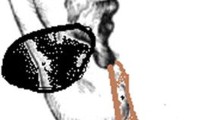Abstract
Purpose
To investigate the anatomical relationships between the structures adjacent to the cartilaginous portion of the ear canal in children with Work type I congenital branchial cleft anomalies (CFBCAs) and to develop new classifications and surgical strategies.
Methods
Retrospective analysis was performed on 50 children with Work type I CFBCAs admitted between December 2018 and December 2022.
Results
Among the 50 children, total parotidectomy was performed on 49 sides. In 44 cases (88%), the main body of the lesion was closely associated with the cartilage of the inferior ear canal wall. Among these cases, the lesions in 40 cases occurred within the space enclosed by the dorsal inferior wall cartilage, mastoid process, and parotid gland, while in the remaining four cases, the lesions were located between the anterior inferior wall cartilage and parotid gland. Based on the preoperative imaging observations, clinical manifestations, and intraoperative findings, the cases were classified into 6 subtypes (a to f) including 21 cases (42%) of Type Ia (inferior wall of EAC), 7 cases (14%) of Type Ib (bottom wall of EAC), 12 cases (24%) of Type Ic (posterior–inferior wall of EAC), 4 cases (8%) of Type Id (anterior–inferior wall of EAC), 4 cases (8%) of Type Ie (anterior ear wall of EAC), and 2 cases (4%) of Type If (isolated from parotid).
Conclusion
Surgical intervention is the only treatment for first branchial cleft anomalies and a comprehensive understanding of the classifications will help with the precise localisation and excision of the lesions.





Similar content being viewed by others
Data availability
Data is available in this manuscript.
References
Magdy EA, Ashram YA (2013) First branchial cleft anomalies: presentation, variability and safe surgical management. Eur Arch Otorhinolaryngol 270:1917–1925
Quintanilla-Dieck L, Virgin F, Wootten C, Goudy S, Penn E Jr (2016) Surgical approaches to first branchial cleft anomaly excision: a case series. Case Rep Otolaryngol 2016:3902974
Work WP (1972) Newver concepts of first branchial cleft defects. Laryngoscope 125:520–532
Olivas AD, Sherman JM (2017) First branchial cleft anomalies. Oper Tech Otolaryngol Head Neck Surg 28:151–155
Liu W, Chen M, Hao J, Yang Y, Zhang J, Ni X (2017) The treatment for the first branchial cleft anomalies in children. Eur Arch Otorhinolaryngol 274:3465–3470
Li W, Zhao L, Xu H, Li X (2017) First branchial cleft anomalies in children: experience with 30 cases. Exp Ther Med 14:333–337
Del Pero M, Majumdar S, Bateman N (2007) Presentation of first branchial cleft anomalies: the Sheffield experience. J Laryngol Otol 121:455–459
D’Souza AR, Uppal HS, De R (2002) Updating concepts of first branchial cleft defects: a literature review. Int J Pediatr Otorhinolaryngol 62:103–109
Ertas B, Gunaydin RO, Unal OF (2015) The relationship between the fistula tract and the facial nerve in type II first branchial cleft anomalies. Auris Nasus Larynx 42:119–122
Chan KC, Chao WC, Wu CM (2012) Surgical management of first branchial cleft anomaly presenting as infected retroauricular mass using a microscopic dissection technique. Am J Otolaryngol 33:20–25
Olsen KD, Maragos NE, Weiland LH (1980) First branchial cleft anomalies. Laryngoscope 90:423–436
Liu W, Chen M, Liu B, Zhang J, Ni X (2021) Clinical analysis of type II first branchial cleft anomalies in children. Laryngoscope 131:916–920
Bagchi A, Hira P, Mittal K, Priyamvara A, Dey AK (2018) Branchial cleft cysts: a pictorial review. Pol J Radiol 83:e204–e209
D’Souza AR, Uppal HS, De R, Zeitoun H (2002) Updating concepts of first branchial cleft defects: a literature review. Int J Pediatr Otorhinolaryngol 62:103–109
Liu W, Liu B, Chen M, Hao J, Yang Y, Zhang J (2018) Clinical analysis of first branchial cleft anomalies in children. Pediatr Investig 2:149–153
Chen L, Zhang B, Xu M, Zhou Z, Huang Y, Xu X, Liang L, Gong X, Huang S (2020) Classification and surgical strategy of Work I congenital first branchial cleft anomaly based on adjacent anatomy. J Clin Otothinolaryngol Head Neck Surg (China) 34:695–700
Triglia JM, Nicollas R, Ducroz V, Koltai PJ, Garabedian EN (1998) First branchial cleft anomalies: a study of 39 cases and a review of the literature. Arch Otolaryngol Head Neck Surg 124:291–295
Maithani T, Pandey A, Dey D (2014) First branchial cleft anomaly: clinical insight into its relevance in otolaryngology with pediatric considerations. Indian J Otolaryngol Head Neck Surg 66:271–276
Funding
This study was funded by the National Natural Science Foundation of China (Grant number: 82071038).
Author information
Authors and Affiliations
Contributions
Conception and design: JB, BY, and YF; administrative support: YF; provision of study materials or patients: BY, BX, and YZ; collection and assembly of data: JB and BY; data analysis and interpretation: JB and BY; manuscript writing: JB; final approval of manuscript: all the authors.
Corresponding author
Ethics declarations
Conflict of interest
The authors have no conflicts of interest to declare.
Ethical approval
All the procedures performed in studies involving human participants were in accordance with the ethical standards of the institutional and/or national research committee and with the 1964 Helsinki Declaration and its later amendments or comparable ethical standards.
Informed consent
Informed consent was obtained from all of the families of individual participants included in the study.
Additional information
Publisher's Note
Springer Nature remains neutral with regard to jurisdictional claims in published maps and institutional affiliations.
Rights and permissions
Springer Nature or its licensor (e.g. a society or other partner) holds exclusive rights to this article under a publishing agreement with the author(s) or other rightsholder(s); author self-archiving of the accepted manuscript version of this article is solely governed by the terms of such publishing agreement and applicable law.
About this article
Cite this article
Bi, J., Yu, B., Fu, Y. et al. New classification and surgical strategy for work type I congenital first branchial cleft anomalies in children. Eur Arch Otorhinolaryngol 280, 5539–5546 (2023). https://doi.org/10.1007/s00405-023-08140-4
Received:
Accepted:
Published:
Issue Date:
DOI: https://doi.org/10.1007/s00405-023-08140-4




